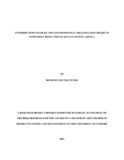| dc.description.abstract | NGOs projects contribute significantly in terms of poverty eradication, health provision, child
mortality reduction, water and sanitation provision, and, education provision for economic
empowerment. The NGO sector provides employment for over 132 million people in the world
and over 2million people in Kenya thus raising their living standards. The NGOs have operated
in the country since before independence as either social organization, CBOs, church based
voluntary organizations and many more. They have served in providing support for the less
fortunate people or emergency situations in the country where the government couldn’t cover.
Remarkably, the seven core objectives of Plan International in Africa and Kenya have been a
boost to the NGOs world. In this note, the research aimed at focusing on the role of NGOs in
poverty reduction in Kwale County. The research looked at the roles of NGOs like Plan
International in Kwale County in five sub-headings/objectives that include: The role of education
provided by Plan International in poverty reduction, Health provision role, Water and Sanitation
role, Economic empowerment role, and Child Survival role. Comprehensive literature review
was done to gather information on the role of NGOs projects in poverty reduction from the
previous researchers, followed with structured questionnaire distribution and interview as tools
to collect data. Random sampling technique was selected as the appropriate sampling method
giving equal chances to the population. The total population of 98 respondents was considered
for the study, although focused interview schedules were conducted between the researcher and
10 focused group discussions of 10 individual each. The response rate was 91.84% positive,
meaning that 90 questionnaires were fully filled and returned; thus valid for the study. The total
study was then taken to be 90 valid questionnaires. From the discussions with the focused group
discussions, the various roles played by Plan International were evident as supported by over 9
groups out of the 10. From the results of the study in chapter four, the chi-square values for all
the objectives were greater than the critical value of 9.488; meaning that the alternative
hypotheses were all valid. This means that alternative hypotheses were adopted while the null
were rejected. Discussion of the findings and recommendations for future studies; including
future similar studies in other counties, can be found in chapter five while the elaborate figure of
locale of the study has been attached at the end of the document. | en_US |

